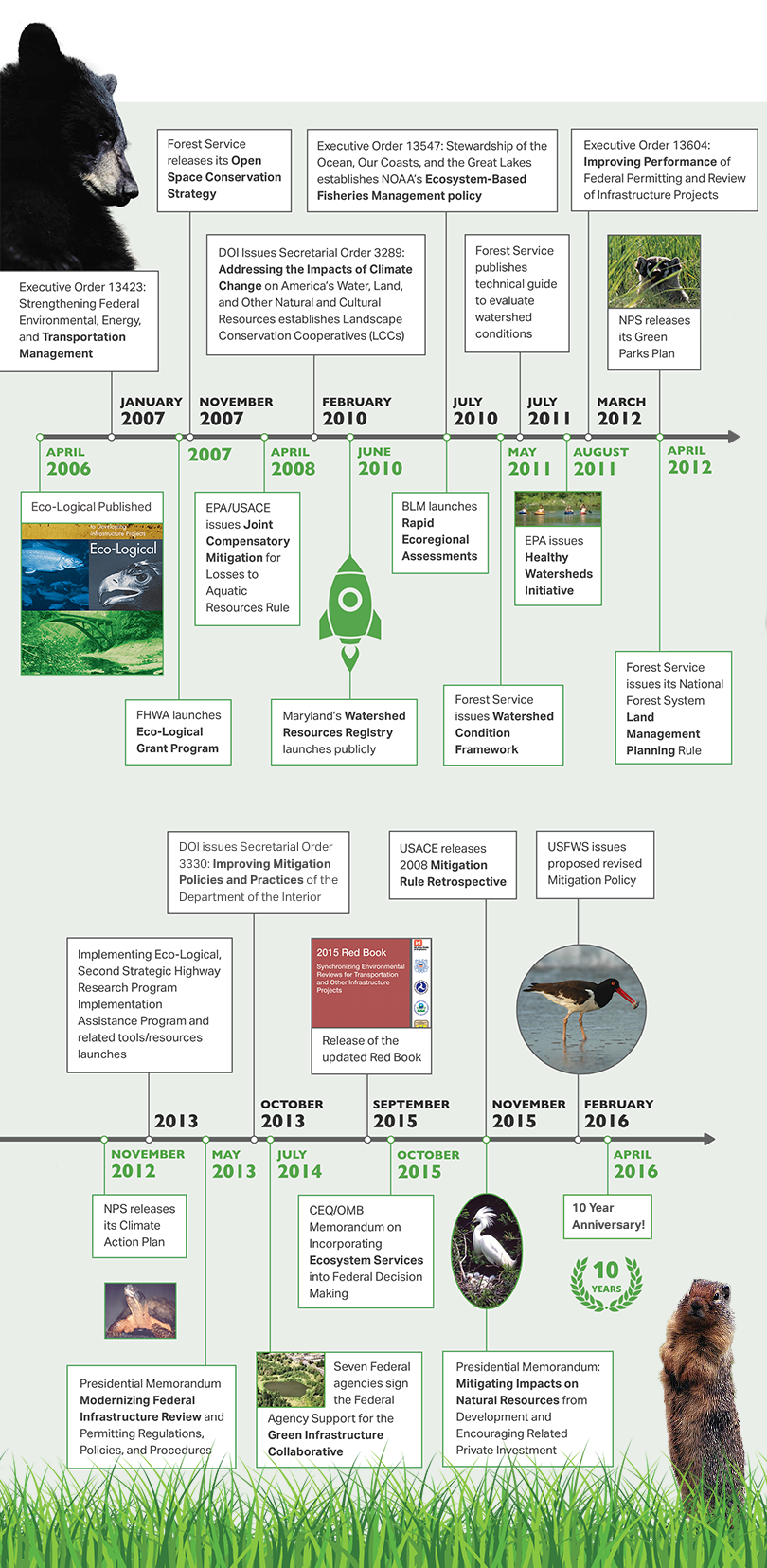Printer-friendly PDF →
Eco-Logical Reaffirmation
2016 marks the 10-year anniversary of a significant milestone. Ten years ago, eight Federal agencies developed and came to a consensus on a shared vision of how infrastructure development and ecosystem conservation can be integrated to harmonize economic, environmental, and social needs and objectives. These agencies documented and signed off on that vision in Eco-Logical: An Ecosystem Approach to Developing Infrastructure Projects, and placed it into practice.
Eco-Logical focuses on:
- Impacts of infrastructure on a landscape scale;
- Building collaborative partnerships;
- Increasing the scale and pace of conservation and restoration while preserving or enhancing connectivity;
- Improving interagency communication and training opportunities;
- Establishing increased data sharing; and
- Accelerating project development and delivery, while conserving resources at the landscape scale.
Since 2006, the eight Eco-Logical signatory agencies have all strived to implement a landscape-scale approach. Each agency has worked independently to foster the Eco-Logical approach within their agency, and pursued opportunities to collaborate across agencies. The following is a list of the signatory agencies and some of their notable accomplishments.
- Bureau of Land Management has initiated 14 Rapid Ecoregional Assessments since 2010 to provide information and tools for land managers and stakeholders to use in resource planning and decisionmaking.
- U.S. Department of the Interior has established 22 Landscape Conservation Cooperatives (LCCs) to better integrate science and management to address climate change and other landscape-scale issues.
- Environmental Protection Agency partnered with the U.S Army Corps of Engineers, Federal Highway Administration, and the State of Maryland to develop the Watershed Resources Registry (WRR) to implement a watershed approach to land-use planning and regulatory and non-regulatory decisionmaking.
- Federal Highway Administration has given over $3.2 million in grant funds for agencies to implement the Eco-Logical approach.
- National Oceanic and Atmospheric Administration Fisheries Service has conducted Integrated Ecosystem Assessments (IEAs) in five of the Nation’s eight large marine ecosystems to ensure consideration of diverse needs and activities in the management of coasts and waterways.
- National Park Service began to estimate the effects of climate change on their coastal parks by developing a report on the exposure to park infrastructure and assets based on 1 meter of sea level rise. This information is being used in Regional Long Range Transportation Plans to further inform resource stewardship and asset management strategies.
- U.S. Army Corps of Engineers approved 738 mitigation banks and 52 in-lieu fee programs since 2008. Additionally, USACE, with support from USFWS, FHWA, EPA, and NOAA, has rolled out the Regulatory In-Lieu Fee and Bank Information Tracking System (RIBITS) nationally as a tool for tracking and displaying information on Clean Water Act Section 404 and Endangered Species Act compensatory mitigation. As a common data platform, RIBITS has contributed to data sharing and to standardizing bank and in-lieu fee program data nationally.
- U.S. Department of Agriculture, Forest Service achieved the milestone of 2,100 road-stream crossings removed or upgraded for Aquatic Organism Passage using Federal Highway Administration funding including Legacy Roads and Trails and partner funding between 2008 and 2015.
While some initiatives lose momentum and focus as time goes on, Eco-Logical has only continued to grow in use and awareness since its inception. The successes above are just a few examples of the positive influence Eco-Logical has had across agencies. The 10 Years of Eco-Logical Landscape-Scale Activities Timeline commemorates the directives, executive actions, and major agency accomplishments that demonstrate the overall trend toward the landscape-scale approach. The timeline serves as a celebration of Eco-Logical as the document that formalized agency collaboration and implementation of the landscape-scale approach.
10 YEARS
OF ECO-LOGICAL
LANDSCAPE-SCALE ACTIVITIES

View the extended description of the timeline ⇒

While things have certainly changed over the past ten years, we have the same mission today that we had in 2006. The Eco-Logical signatory agencies will actively continue the work they have fostered around this landscape-scale approach and work to collaborate to further advance this effort. In the next ten years and beyond, the signatory agencies hope to achieve a shift from Eco-Logical as an “approach” to a business-as-usual practice across the Government. The signatory agencies also aim to:
- Increase the knowledge and adoption of the landscape-scale approach;
- Advance data sharing amongst agencies;
- Address emerging risks such as climate change; and
- Expand the knowledge of Eco-Logical beyond its current reach to academia, so the next generation of practitioners is familiar with the landscape-scale approach.
The future of Eco-Logical implementation is being shaped by a philosophical change across Federal government. This is demonstrated by the following recently released documents:
- The updated Red Book, released in September 2015, will help Federal, State, and local agencies implement more efficient and concurrent review processes for transportation and some infrastructure projects. The Red Book specifically mentions the Eco-Logical approach as a way to implement the watershed approach.
- The White House Council on Environmental Quality (CEQ) and Office of Management and Budget (OMB) Memorandum on Incorporating Ecosystem Services into Federal Decision Making, released in October 2015, requires each agency to develop a plan for how it will consider ecosystem services into planning and decisionmaking. Final guidance will be forthcoming.
- The Presidential Memorandum on Mitigating Impacts on Natural Resources from Development and Encouraging Related Private Investment, released in November 2015, underscores the importance of effectively mitigating adverse impacts to resources. To meet the objectives of the Presidential Memorandum, agencies will set performance standards to assess where mitigation is most effective.
- The 2008 Mitigation Rule Retrospective, released by the USACE in October 2015, evaluates the administrative performance of the rule. The retrospective shows the effectiveness of the mitigation sequence (avoidance, minimization, compensation) in protecting the Nation’s aquatic resources.
The Eco-Logical signatory agencies will continue to foster a collaborative interagency dialogue and expand the influence of Eco-Logical and the landscape-scale approach This formula has served well since Eco-Logical’s inception and will continue to do so in the future. The commitment to the landscape-scale approach remains strong.

Return to top ⇑

